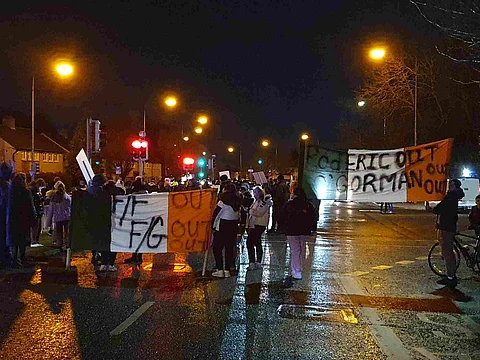

Ireland’s Dublin city witnessed its worst riots in decades on the night of November 23, Thursday, as violent far-right mobs damaged and looted over a dozen shops, chased and attacked Garda (the Irish police force) personnel, and set ablaze buses, trams, and Garda cars. The violence, which started off as ‘protests’, was at least partly in response to a brutal stabbing that took place outside a primary school near the Rotunda Hospital on Parnell Street on Thursday afternoon. The attack had left five people including three children hospitalised — one of whom, aged five, has sustained serious injuries and remains in a critical state.
Garda (Police) Commissioner Drew Harris confirmed on Friday morning that a suspect has been identified in the stabbing attack, and the investigation is ongoing. But even as the motive behind the attack is yet to be made public, a strongly conservative news website called Gript Media claimed that the suspect was “understood to be an Algerian national,” feeding a growing anti-immigrant sentiment among right-wing groups in the country. Social media handles have since pointed out that the man has been an Irish citizen for over two decades, but the article by Gript remains online. Gript also leaves out the detail that the first responder who stopped the attack is a Brazilian delivery worker.
Violent ‘protests’
On Thursday, shortly after the stabbing, groups of protesters began to gather in the area. In his briefing on Friday, Commissioner Harris said a group also attempted to break through the police barrier to the scene. Crowds soon grew more violent, channeling their anger both at migrants and the government. Videos widely shared on social media showed crowds setting a police car, tram, and bus on fire. Other videos emerged of Garda members being chased through the streets and attacked by large mobs of people.
Even as conservative groups tried to argue that the protests were a mere outpouring of public anger against the government, videos showed the rioters looting shops including the iconic Arnotts Shopping Centre. One video showed rioters storming an eatery, with someone asking to grab the charity boxes. Anti-migrant and anti-government posts popped up in right-wing social media groups, with some worrying unverified reports of calls for violence against “foreigners” and Garda members who had “blood on their hands”.
The larger public in Ireland condemned the riots, calling them “disgraceful”. A large proportion of the public took to X, formerly Twitter, to call out the far-right groups that created the chaos. One user wrote:
Others blamed the government for its failure to see clear warning signs that a violent far-right protest had been simmering for months.
Commissioner Harris confirmed that 34 people have been arrested for public order offences overnight, and investigations are underway to identify others. He said the unrest was caused by a “lunatic, hooligan faction driven by far-right ideology.”
President Michael D Higgins said in a statement that the nation’s prayers were with victims of the school stabbing, and warned that the attack on the school was being “abused by groups with an agenda.”
Simmering tensions
Most people who follow Irish politics closely, will agree across the political spectrum that there has been widespread public anger against the government’s handling of many issues like housing, cost of living, and poverty. Although many of the protests about such issues have been led by Left-leaning groups and political parties, right-wing marches have steadily become a breeding ground for anti-migrant, racist, and anti-LGBTQ+ chants.
Ireland has a history of standing strongly in solidarity with oppressed peoples, be it against the apartheid in South Africa in the 1980s, or the ongoing plight of Gazans. When the Ukrainian refugee crisis displaced millions fleeing from Russian aggression, Ireland accepted many of them, building transitional shelters across the country for the roughly 60,000 who came in. Some hotels and offices across Dublin city were also opened up to accommodate asylum seekers as they await their applications. Neighbourhoods like Ballymun and Finglas in north Dublin, already reeling under poor infrastructure and economic conditions, have been a venue for anti-immigrant protests over the last year. The protests were under the right-wing slogan #IrelandIsFull, which was also trending on X Thursday night.
But the government’s failure to keep a check on the rising rental market, mounted by the lack of social housing and controversial permits being given to hotels and business establishments, has led to rising resentment against the establishment. Many far-right groups, which have become increasingly vocal in recent months, in turn used these concerns to whip up anti-immigrant sentiments among the people. In September, aggressive protests outside the Parliament led to discussions about the real danger of far-right protests.
Tougher response
Asked if the events of last night show a “failure of personnel”, the Garda Commissioner responded that there was a need to revisit their tactics for public order, adding that “we have seen an element of radicalisation” that may require a new “proportionate” response. The unprecedented scenes mean that the government will need to now weigh their response to the rising public discontent, but also ensure that it adequately addresses the now visible violent turn that the far-right groups have taken.
S Harikrishnan is an Assistant Professor at Dublin City University and a founding editor of Ala. He has lived in Dublin since 2015.